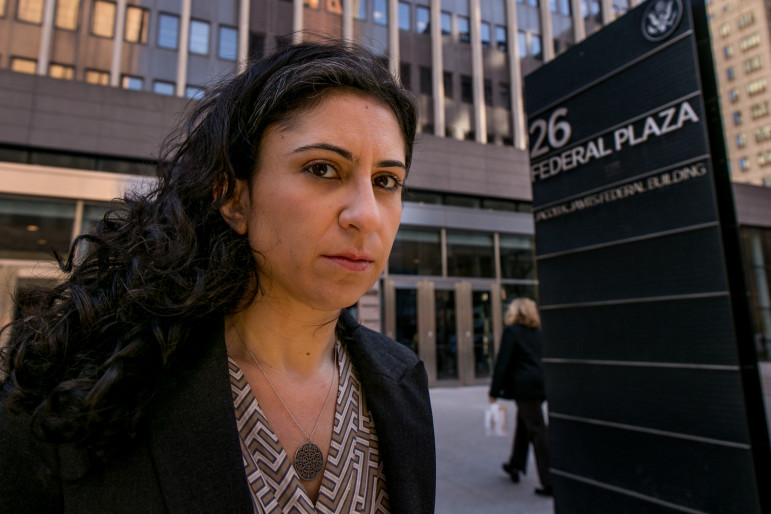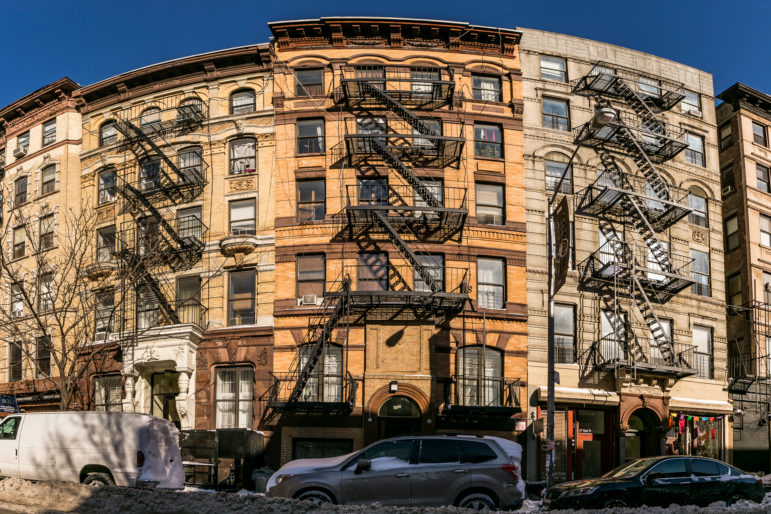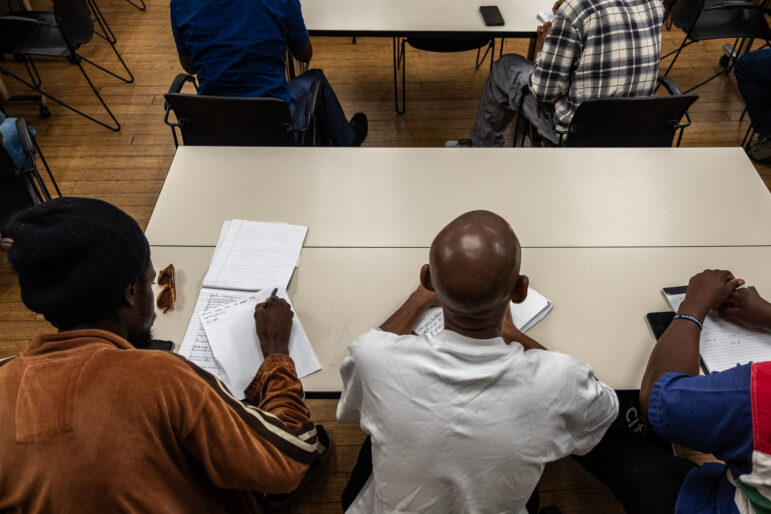
Adi Talwar
Talia Peleg, an immigration attorney at Brooklyn Defender Services, represented Alex Lora in a case that would eventually reset immigration court policy in the New York City area and beyond.
This is the second part of a five-story series on the policy problems and human dramas that characterize immigration court in the New York City area. Be sure to check out the rest of the series.
* * *
There is an irony to calling immigration a civil matter. “You can’t say they aren’t being treated like criminals,” says Craig Relles, a lawyer who specializes in immigration, of immigrant detainees. “They are housed in county jails. They are wearing prison garb, they are eating prison food. There’s only one other place where you don’t get a hearing and you just sit in jail. You know where that is? Guantanamo.”
Or, as a report by the American Immigration Council put it, “For a country that prides itself on fair treatment under the law, the lack of due process is an embarrassment and a danger, as it demonstrates how easily civil liberties can be eroded.”
Advocates and immigrants alike call it a “double punishment”—having served their time for the crime they committed or pled out, they are now punished again for the same crime. As one lawyer put it, “What’s the point of detaining them? They’ve been out for years! Now they’re a threat to society?” When asked about this, an ICE spokesperson responded, “ICE focuses detention resources on the removal of priority aliens.”
Taxpayers are paying for this second incarceration; it costs upwards of $120 a day t0 house a detainee in Hudson. Despite this, Congress has mandated that the Department of Homeland Security fill 34,000 beds, forcing ICE to reach further into communities and incarcerate more immigrants to hit that number.
Since that mandate went into effect in 2009, the number of people detained each year has increased from 383,524 to 477,000 in 2012. According to a study done by the Detention Watch Network, in the last decade, the detention system grew by 75 percent, an expansion that relies heavily on ICE’s use of private contractors to operate and provide services at immigration jails across the country. “This interdependent relationship with private industry has produced a set of government-sanctioned detention quotas that ensure profits for the companies involved while incentivizing the incarceration of immigrants,” DWN wrote in their report. Over $2 billion in the 2016 budget for detention operations will ultimately go to for-profit contractors.
When asked about whether quotas are incentivizing, the ICE spokesperson wrote, “ICE makes custody determinations on a case-by-case basis with a priority for detention of serious criminal offenders and other individuals who pose a significant threat to public safety.”
But it’s not only the double punishment aspect of detention that bothers advocates. Whether an immigrant is detained makes an enormous difference in the outcome of their immigration cases down the line.
A 2012 study launched by Second Circuit Judge Robert A. Katzmann found that people facing deportation in New York who had a lawyer and were not detained managed to win their cases four times as often as those who had counsel but were locked up.
Still more important, however, was the presence of a lawyer. Katzmann’s study found that non-detained respondents with lawyers were five times more likely to win in immigration court. Among detained people, those with lawyers were six times more likely to prevail.
A person detained, without a lawyer, only had a favorable outcome 3 percent of the time, the study found.
Facing a judge alone
Those dismal statistics take on a human face in courtrooms like the one at the Elizabeth Contract Detention Center, located at the end of a desolate street near Newark Airport that is also home to hundreds of Fed-Ex trucks. To get into the courtroom, you have to leave all your possessions in a dirty locker and pass through a metal door, then a metal detector, where you take off your shoes before passing through. The friendly guard will press a button and another metal door will slide open, leading to a small vestibule. When that door clanks shut behind you, a second metal door will open, leading to a waiting room and finally to the courtrooms.
Despite all the fanfare, there were no prisoners present in court the day I visited in early December. Instead, they were teleconferenced in from the jails where they were being detained—the Essex County Correctional Facility or the Hudson jail—via a large screen facing the courtroom.
The judge would call out a number, and the guard would go and bring the corresponding detainee. The noise from the prison sometimes made it difficult to hear what was being said in the courtroom, and the detainees would lean in with furrowed brows, trying to hear the translator. There was one translator for the courtrooms for a few hours in the morning, but she had to be at Newark at 1 p.m., so the majority of the cases were translated through calling a service that the judge would dial into through the phone, which was on speaker. The tinny voice on the phone would translate the detainee’s words, which came through the video feed. Throughout the day, the screen frequently went blank when the wireless connection at the jail failed and the video feed cut out; the detainee’s face would then be replaced by an American flag and the Department of Justice logo.
The majority of the detainees had no lawyer. They would appear on the screen and the judge—Judge Dorothy Harbeck—would ask them a series of questions. She asked if they needed time to get a lawyer (all but one said no), whether they were afraid to return to their home country, and whether they had family in the U.S. Then she would ask them about their arrest record in order to determine if they were eligible for bond. When she was done, she would turn to the government attorney and ask for his input. On the day I sat in her courtroom, no one got bond.
The youngest detainee was nineteen, the oldest in his sixties. Their crimes ranged from domestic violence to assault with a deadly weapon. More than one hadn’t filled out their asylum application because they couldn’t find anyone to help them translate from Spanish to English. More than one tried to explain that they had pled guilty to crimes they hadn’t committed in exchange for time served, no doubt not realizing the huge consequences this would have later in life (Many criminal defense lawyers don’t explain that such a plea can result in deportation).
A 20-year-old man appeared on the screen in an orange jumpsuit wearing a silver cross. He had been arrested in September and was being detained for violating a restraining order. His only other arrest had been in 2012, when he was arrested while with friends and charged with being a gang member—a charge that was dismissed.
When the judge turned to the government attorney to ask why the young man was being detained, the government lawyer told her he had been charged with a homicide in July of 2015. But when the judge asked the detainee if that were true, he said no. The government lawyer admitted that it didn’t appear on his rap sheet, but rather on an internal database.
“What does that mean?” the judge asked.
“I don’t know,” the government lawyer confessed. “I just got the case this morning.”
Through the translator, the judge told the detainee that she was concerned about the homicide charge. “If the government doesn’t have back up for the homicide, it’s likely you’re eligible for a bond,” she told him.
She gave the government lawyer until December 29 to figure out if the charge was actually his—meaning three more weeks in detention for the detainee.
Later in the day, a thin man in his thirties with an angular face and black hair appeared on the screen. He, too, was representing himself. When the judge asked if he had a fear of returning to his home country of Ecuador, he said no. Through the translator, he explained, “Unfortunately I came here because of poverty. I do not have a father and I came for my family. I would like to ask your honor for bond because I do not think I qualify for anything else.”
“The court can’t give you legal advice,” Judge Harbeck said. “But I can appreciate your reasons for coming to the United States. Do you have any family here?”
“Yes, but they are illegal as well,” he said.
The judge explained that if he had been persecuted or had a fear of future persecution, he may be eligible for asylum.
“Do you want the opportunity to fill out an asylum application?” she asked him.
“I would like to know if I can qualify for bond,” he said again through the translator. “Because I don’t think I can qualify for asylum. I have no proof. The truth is, I don’t know much about asylum. I imagine you need proofs and I don’t have proofs.”
The judge repeated impatiently that she could not offer him legal advice. She told the officer at the prison to give him an asylum application, and turned to his bond hearing. The man had been detained after being arrested for simple assault, a charge that was dropped—he held up a piece of paper on the screen. He had also been arrested in his driveway with a bunch of friends—they were drunk, he explained apologetically.
The judge turned to the government lawyer.
“He has an open warrant in New York,” the government lawyer said.
It was for a DUI—the time he was arrested with his friends in the driveway.
“Why didn’t you appear in court and tell the judge you weren’t driving?” The judge asked.
“I went to say that, but the police said you cannot speak against them,” he explained.
“I’m going to deny the request for bond because the respondent presents a flight risk, because of the bench warrant in New York,” Judge Harbeck said. She suggested he take care of the warrant in New York before their next calendar date.
“Can you explain more?” The detainee asked desperately, but just then, the video feed cut out.
“I want the record to reflect how inefficient this all is,” Judge Harbeck grumbled.
City program offers hope
The results of Judge Katzmann’s report were so shocking that New York’s City Council created the New York Immigrant Family Unity Project, or NYIFUP, to represent immigrants facing deportation. The program began as a pilot in 2013, then took larger scale last year when city lawmakers allocated $4.9 million to three legal non-profits—the Bronx Defenders, Brooklyn Defender Services, and the Legal Aid Society—to cover all immigrants who are detained and facing deportation.
It was during the program’s pilot phase in November 2013 that Talia Peleg, a lawyer for the Brooklyn Defender Services (BDS) began going to immigration court on Varick Street to meet with detainees on Tuesdays, taking whatever cases came through the door.
If Alex Lora, the man picked up by ICE earlier that year on a drug case for which he’d served probation, had been arrested in any other city in the U.S., he would never have met a person like Peleg. He would in all likelihood have represented himself, and he would have faced a 97 percent chance of deportation. Instead, he qualified for NYIFUP, which is open to detainees whose income is less than 200 percent of the federal poverty line, covering most detained immigrants. He was led into a room in the Varick Street Immigration Court, and there was Peleg.
“I just wanted to go home,” Lora recalled with a chuckle. “But she gave me her word she would get me out.” Peleg doesn’t remember making that promise, but says she at some point realized his case might be winnable, and after that, she pushed him to hang on just a little longer. “Many times he wanted to give up,” Peleg remembered. “‘Talia, I can’t’,” she recalled him saying.
Lora explained that if he had been sentenced to six months in detention as punishment for a crime he had committed, he could have prepared himself mentally to do that time. “But when you’re not prepared for something and they just grab you out of nowhere, take you out of your environment in a split second, tell you it’s for one problem and actually it’s for another problem, and there is no end …” He shook his head.
With the resources granted by NYIFUP, Lora and Peleg now had the bandwidth to pursue a higher appeal. Peleg’s colleague, Bridget Kessler, filed a habeas corpus petition— a legal action allowing detainees to seek relief from unlawful imprisonment—and she won at the district court level. ICE agreed to release Lora on $5,000 bond.
Kessler then recruited the NYU Immigrant Rights clinic, and together they took Lora’s appeal to the Second Circuit Court of Appeals, who concluded in a groundbreaking October decision that holding anyone in mandatory detention for longer than six months without a bond hearing was an affront to due process.
“No doubt an appreciable number of these detainees have criminal records that subject them to mandatory detention,” the Second Circuit Court determined in a decision called Lora v. Shanahan. “On the other hand, this group includes non-citizens who for a variety of individualized reasons are not dangerous have strong family and community ties and are not flight risks and may have meritorious defenses to deportation.”
The decision meant that one week in November, countless immigrants were going to get what were being called “Lora hearings,” focused not on whether they’d be deported or not—that would be decided later—but whether they were eligible for release from detention on bond to await the completion of their case.
The ruling meant many detainees would face a judge for a bond hearing for the first time.
Immigration Court Crisis
Weighs on Lawyers, Families
City Limits is grateful to the readers who donated to create this project along with the generous underwriting of Beacon.
* * *









3 thoughts on “Immigrants’ Fates Depend on Access to Lawyers”
WHAT A MORON….we need to eliminate all interpreters from immigration hearings. If you cant read, write and speak English to the judges and clerks, then why are you still here?
Their fates are the results of their own actions. Every human knows that there are consequences for breaking the law. If you came to the US on a B2 visitor visa, then decided to not leave, you broke the law. If you came to the US illegally by crossing the border at a place other than a POE, you broke the law. The consequence now is you could be deported. If you are unwilling to face the consequences, don’t commit the crime.
First of all, if you was in this mess I know you wouldn’t be saying such response to this. Suppose you didn’t do the crime and you were accused. Have you ever thought of that.